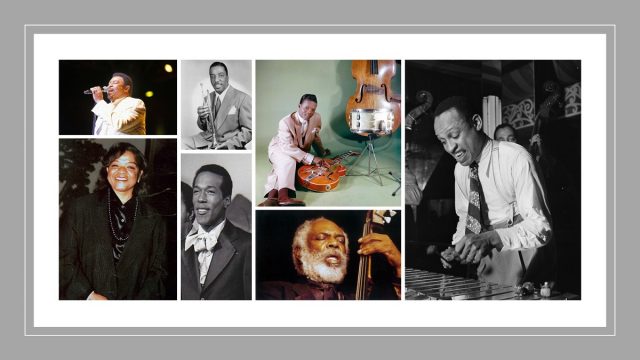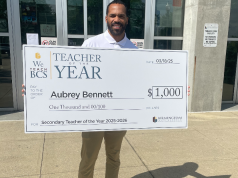
Alabama News Center
In 1989, Erskine Hawkins, Sun Ra and The Temptations all played at Birmingham’s inaugural City Stages music festival. Tickets that year were $3 per day and $1 for children. Beyond the great admission price, it was a Golden Oldies day for music in Birmingham.
The orchestras of Hawkins and Ra, combined with the headlining Temptations, brought the Magic City a sampling of the best performing artists to ever emerge from Alabama’s biggest metro. The Birmingham trio who led the Temps, the man known as “The 20th Century Gabriel” and the cosmic jazz band leader who graced the cover of Rolling Stone were influential worldwide. They are but a small slice from Birmingham’s extensive musical pipeline that has poured out prominent performers throughout the city’s 150-year history.
It’s impossible to highlight all the musical stars whose light first shined in Birmingham. Some, like Tammy Wynette, barely passed through town on their way to the spotlight. Just hitting the superlatives of the legendary singers and players who were born or raised in the town is difficult.
As Birmingham closes out its 150th birthday celebration, Alabama NewsCenter is putting the final touches on our yearlong series about the region’s history with a four-part package about musical legends with ties to the Magic City.
Fitting with the holiday season, the first two parts focus on the ghosts of Birmingham’s music past – those performers who are no longer with us. The final two parts focus on the more modern heroes of Birmingham’s musical legacy.
Since ranking musical greatness is always dicey, we’ve taken a less controversial route and listed these musical greats alphabetically. For Part 1, we share the first seven of our Birmingham baker’s dozen of past music stars.
Hank Ballard
Born John Henry Kendricks (1927-2003) in Detroit, Michigan, he grew up and attended school in Bessemer. Ballard began singing in church, but his inspiration was the “Singing Cowboy,” Gene Autry, and his signature song “Back in the Saddle Again.” Ballard returned to Detroit in his teenage years and later worked on the Ford Motor Co. assembly line.
Ballard sang in the Detroit bands The Royals and The Midnighters, releasing five sexually tinged pop songs that became R&B chart hits in 1954-55. By 1959, the group was billed as Hank Ballard and The Midnighters. Between 1959 and 1961 they had hits on both the R&B and pop charts, starting with “Teardrops on Your Letter,” which reached No. 4 in 1959 with a B-side Ballard-written song “The Twist.” A few months later, Chubby Checker‘s cover of the song went to No. 1 on the pop charts. Checker would take “The Twist” to the top of the charts again in 1962, making him the only singer in the rock ‘n’ roll era to reach No. 1 in two nonconsecutive years with the same song.
Ballard and The Midnighters had several other hit singles, including the Grammy-nominated “Finger Poppin’ Time” (1960) and “Let’s Go, Let’s Go, Let’s Go” (1960), which hit No. 7 and No. 6, respectively.
Ballard went solo after 1965. The single, “How You Gonna Get Respect (When You Haven’t Cut Your Process Yet),” was his biggest post-Midnighters hit, reaching No. 15 on the R&B chart in 1968.
James Brown produced Ballard’s 1969 album “You Can’t Keep a Good Man Down.” His 1972 single, “From the Love Side,” went to No. 43. Ballard sang on two tracks of Brown’s popular album “Get on the Good Foot.” Ballard raps behind Brown on the album in “Recitation By Hank Ballard.”
In 1990, Ballard was inducted into the Rock & Roll Hall of Fame. The other Midnighters were inducted in 2012.
Nell Carter
Alabama Legacy Moment: Nell Carter from Alabama NewsCenter on Vimeo.
Nell Ruth Hardy (1948-2003) was born in Birmingham, one of nine children in her family. She began singing at an early age on a local gospel radio show and in her church choir. Hardy was 15 when she began performing with the Renaissance Ensemble.
She revealed in a 1994 interview that three decades earlier she was raped at gunpoint by a man she knew who gave her a ride home from an Ensemble performance. Nine months later, she gave birth to a baby she sent to live with her older sister. In 1967, Hardy moved to New York with the ensemble and changed her surname to Carter.
In New York City, Carter broke into stardom in the musical “Ain’t Misbehavin’,” for which she won a Tony Award in 1978. She won an Emmy for the same role in a televised performance in 1982.
In 1981, Carter took a role on “The Misadventures of Sheriff Lobo” before landing the lead role of Nell Harper on the sitcom “Gimme a Break!” The series was a hit for NBC from 1981-87 and earned Carter nominations for Golden Globe and Emmy awards.
In the mid-1990s, Carter appeared on Broadway in a revival of “Annie” as Miss Hannigan. She was upset when television ads promoting the show used a white actress as Miss Hannigan. Producers said the commercials were made during a previous play production and were too costly to reshoot.
“Maybe they don’t want audiences to know Nell Carter is Black,” she told the New York Post. “It hurts a lot. I’ve asked them nicely to stop it – it’s insulting to me as a Black woman.”
Carter died in her Beverly Hills, California, home and was buried in Los Angeles.
Cleve Eaton
Cleveland Josephus Eaton II (1939-2020) was born in Birmingham. He began studying music when he was 5 and turned to the saxophone at 8. By 15, he had mastered the piano, trumpet, tuba and bass. He began playing bass after legendary music teacher John T. “Fess” Whatley allowed him to take the instrument home from Birmingham’s Industrial High School. Whatley had previously mentored Sun Ra and Erskine Hawkins.
Eaton played in a jazz group at Tennessee A&I State College, where he earned a bachelor’s degree in music. He would eventually play bass on more than 100 albums and compose about 300 songs.
Eaton was dubbed “the Count’s Bassist” while spending 16 years with the Count Basie Orchestra. Eaton performed with Nancy Wilson, Peggy Lee, Sammy Davis Jr., Julie London, Brook Benton, Lou Rawls, Nipsey Russell, Herbie Hancock, The Platters, The Temptations and The Miracles. As a member of the Ramsey Lewis Trio for 10 years, Eaton played on four gold albums and four singles that also sold at least 500,000 copies.
Eaton played on other notable recording sessions with John Klemmer, The Dells, Bobby Rush, Minnie Riperton, Jerry Butler, George Benson, Henry Mancini, Frank Sinatra, Joe Williams, Billy Eckstine, Sarah Vaughan and Ella Fitzgerald.
In 1974, he began performing and touring with his group, Cleve Eaton and Co. In 1978, he released a disco-themed track called “Bama Boogie Woogie” that reached No. 35 on the BBC charts and proved popular across Europe. As a producer, arranger, composer, publisher and head of his own record company in Fairfield, Eaton in 1975 recorded “Plenty Good Eaton,” which is considered a funk music classic.
After spending years on the road as a musician and arranger, Eaton returned to Birmingham in 1996 to join UAB‘s music department. He was inducted into the second class of the Alabama Jazz Hall of Fame in 1979 and the Alabama Music Hall of Fame in 2008.
Dennis Edwards
Dennis Edwards Jr. (1943-2018) was born in Birmingham and began singing as a 2-year-old in his father’s church. The Edwards family moved to Detroit when Dennis was about 10.
Edwards joined The Temptations in 1968, replacing David Ruffin, and sang with the group from 1968-1976, 1980-1984 and 1987-1989. In the mid-1980s, he attempted a solo career, scoring a hit in 1984 with “Don’t Look Any Further.”
With his rougher, gospel-hewn vocals, Edwards led The Temptations through their psychedelic, funk and disco stages, singing on hits such as “Cloud Nine” (1968); “I Can’t Get Next to You” (No. 1 in 1969); “Ball of Confusion (That’s What the World Is Today)” (1970); “Psychedelic Shack” (1970); “Papa Was a Rollin’ Stone” (No. 1 in 1972); and “Shakey Ground” (1975). “Cloud Nine” and “Papa Was a Rollin’ Stone” combined for three Grammy Awards.
Edwards had a relationship with singer Aretha Franklin, who said he was the inspiration behind her 1972 song “Day Dreaming.” He was briefly married to Ruth Pointer, whom he wed in Las Vegas in 1977. When the couple’s daughter, Issa, was grown, she joined The Pointer Sisters with her mother.
In 1990, Edwards teamed up with Birmingham’s Eddie Kendricks to release a dance/club track entitled “Get It While It’s Hot.” The track was recorded at Frederick Knight’s studio in Birmingham, produced and engineered by house music pioneer Alan Steward. The track was controversial because of a rap sequence that was unpopular with some Temptations fans.
Until his death in a Chicago hospital from meningitis, Edwards was the lead singer of The Temptations Review, a splinter group. The Temptations were inducted into the Rock & Roll Hall of Fame in 1989, the fourth class of the prestigious group, and into the Alabama Music Hall of Fame in 1999, the 15th class of the state group.

Lionel Hampton
Soon after his birth in Louisville, Kentucky, Lionel Hampton’s mother moved him to her hometown of Birmingham. He then spent his early childhood in Kenosha, Wisconsin, before his family moved to Chicago in 1916.
Before he was 20, Hampton (1908-2002) moved to California and switched from drums to vibraphone, which was a new instrument at the time. In 1930, Louis Armstrong was so impressed with Hampton that he was hired to mimic Armstrong’s voice on the vibraphone. Hampton studied at USC and by 1934 had his own orchestra, appearing two years later in the Bing Crosby movie “Pennies From Heaven.”
In 1936, the Benny Goodman Orchestra came to Los Angeles, where Goodman saw Hampton perform. Goodman asked Hampton to join his trio, which became the Benny Goodman Quartet, along with Teddy Wilson and Gene Krupa. Goodman’s trio and quartet were among the first racially integrated jazz groups.
The Lionel Hampton Orchestra was formed in 1940, becoming a high-profile R&B national act that at times included bassist Charles Mingus, guitarist Wes Montgomery, singer Dinah Washington (of Alabama), Dizzy Gillespie, Quincy Jones and other future stars. In 1968, Hampton received a Papal Medal from Pope Paul VI.
From 1933 until 1980, Hampton appeared as himself in 11 movies, including “The Benny Goodman Story” in 1955. Hampton remained active as a performer until he collapsed on stage from a stroke in Paris in 1991.
In 1992, Hampton was inducted into the Alabama Jazz Hall of Fame. Three years later he was made an Honorary Commissioner of Civil Rights by New York Gov. George Pataki. In 1996, President Bill Clinton presented Hampton the National Medal of Arts. That same year, he was inducted into the International Jazz Hall of Fame, performing “Flying Home” with the Count Basie Orchestra. In 2001, Hampton was presented the Harlem Jazz and Music Festival Legend Award.
Erskine Hawkins
Alabama Legacy Moment: Erskine Hawkins from Alabama NewsCenter on Vimeo.
“Way down south in Birmingham, I mean south in Alabam’, there’s an old place where people go, to dance the night away.”
Those words helped make Erskine Hawkins (1914-1993) a legend. The high-note trumpeter and big band leader dubbed “The 20th Century Gabriel” is best remembered for composing the jazz standard “Tuxedo Junction” with saxophonist and arranger Bill Johnson. The song rose to No. 7 nationally in 1939 as recorded by the Erskine Hawkins Orchestra, then jumped to No. 1 when the Glenn Miller Orchestra recorded it during World War II.
Hawkins was named after Birmingham industrialist Erskine Ramsay, namesake of the Birmingham high school. Hawkins went to Parker High when it was known as Industrial High School. He played trumpet in the band directed by “Fess” Whatley, who taught young musicians that went on to play alongside Duke Ellington, Louis Armstrong, and Skitch Henderson and the NBC Orchestra.
While attending Alabama State Teachers College, Hawkins was the leader of the Bama State Collegians, who played in New York City’s Savoy Ballroom during the Great Depression to raise money to help keep the future Alabama State University financially stable.
Hawkins had 24 chart hits, among them No. 1 R&B songs “Don’t Cry Baby” (1943) and “Tippin’ In” (1944). “Caldonia” reached No. 2 in 1945, leading Billboard magazine to call it “right rhythmic rock and roll music,” which is often attributed as the first use of that term. In 1948, “Gabriel’s Heater” soared into the national Top 30.
Hawkins engaged in “battles of the bands” with Glenn Miller, Ellington, fellow Birmingham native Hampton and others. Hawkins’ later recordings would lean more toward R&B, as he became a chief influence on a young Ray Charles.
In 1978, Hawkins was one of the first five artists inducted into the Alabama Jazz Hall of Fame. In 1989, he was inducted into the Alabama Music Hall of Fame, where the Hawkins legacy is often detailed during tours of the museum. Hawkins is buried in Birmingham’s Elmwood Cemetery.
Eddie Kendricks
Eddie James Kendrick (1939-1992) was born in Union Springs but raised in Ensley, where he met Paul Williams. Together they would help form one of the most important singing groups in music history.
Williams and Kendrick met in the late 1940s, long before Eddie added an “s” to the end of his surname. They performed with friends as The Cavaliers in 1955 before moving to Cleveland, Ohio, in 1957, then to Detroit. Their group, The Primes, disbanded and Williams and Kendricks joined with Otis Williams and Melvin Franklin to become The Temptations and sign a recording contract with Motown in 1960. The Temps first charted in the Top 20 nationally in 1964 at No. 11 with Kendricks’ falsetto taking the lead in “The Way You Do the Things You Do.”
Kendricks created most of the group’s vocal arrangements and managed their matching wardrobe. He sang lead on “Get Ready” in 1966 and “Just My Imagination” in 1971, but new producer Norman Whitfield pursued psychedelic soul songs with all five Temps singing lead. Whitfield’s strategy produced a string of hits, including 1968 Grammy winner “Cloud Nine,” “I Can’t Get Next to You” in 1969 and “Ball of Confusion” in 1970.
Kendricks was uncomfortable singing the new style versus the romantic ballads performed under the direction of Smokey Robinson. Often at odds with bandmates Otis Williams and Franklin, he set out on his own in 1971.
Kendricks’ solo career began slowly; he endured two years of singles that each missed the Top 40, while The Temptations continued their Whitfield-helmed hits, such as “Superstar (Remember How You Got Where You Are),” which was written as a jab toward Kendricks and David Ruffin, who also had left the group.
Kendricks scored a No. 1 hit in 1973 with “Keep on Truckin’,” becoming the first Temp to top the U.S. pop charts as a solo artist. The song reached No. 18 in the U.K., sold more than 1 million copies worldwide and was certified platinum. In 1974, “Boogie Down” reached No. 2 in the U.S., selling another million copies, then “Son of Sagittarius” climbed as high as No. 28 the same year. He was nominated for four Grammy Awards.
In 1989, Kendricks, Edwards, Paul Williams and their former Temptations bandmates were inducted into the Rock & Roll Hall of Fame.
By late 1991, Kendricks had moved back to Birmingham and undergone surgery to have a lung removed after 30 years of smoking cigarettes. He continued to tour through the summer of 1992, when he fell ill again and died at Birmingham’s Baptist Medical Center-Princeton. Kendricks was buried in Elmwood Cemetery.
Four tribute concerts at the Strand Theatre in Los Angeles on Oct. 16-17, 1992, included Bobby Womack, Chaka Khan, Mary Wilson of The Supremes and Vesta Williams singing Temptations songs.
On Oct. 16, 1999, Eddie Kendrick Memorial Park was dedicated on the corner of 18th Street and Fourth Avenue North in Birmingham. He and The Temptations received the Grammy Lifetime Achievement Award in 2013.
Editor’s note: The information for the bios of Birmingham musicians was compiled from their websites, as well as Alabama NewsCenter, the Encyclopedia of Alabama, Alabama Jazz Hall of Fame, Alabama Music Hall of Fame, Bhamwiki, Billboard, Country Music Hall of Fame, The New York Times, Rock & Roll Hall of Fame, Rolling Stone, Wikipedia and many other sources.
























